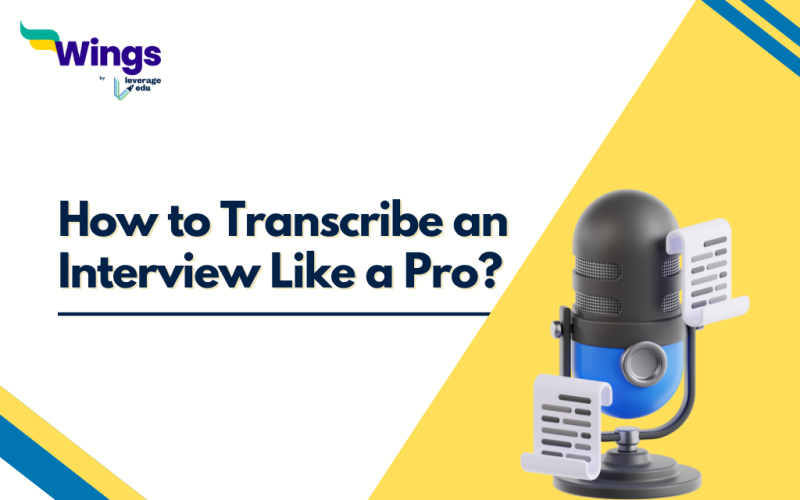Learning the art of transcribing interviews is a vital career skill for job hunters as well as hiring professionals. Accurate and efficient transcription serves as a crucial reference point for decision-making. Also, it is the warehouse of important details and nuances of the conversation between the interviewer and the interviewee. Thus, to help you acquire transcribing skills, we have explained ‘How to transcribe an interview’ in this blog. Keep reading to know the steps.
This Blog Includes:
Also Read: 20+ Phone Interview Questions and Sample Answers
What is an Interview Transcript?
Before we hop on to the question of ‘How to transcribe an interview?’, let us introduce you to the meaning of an interview transcript.
An interview transcript is a written or typed record of a conversation or interview between two or more people. It provides a verbatim account of what was said during the interview, capturing the questions asked by the interviewer and the responses given by the interviewee. Transcripts are often used for various purposes, including research, journalism, legal proceedings, and qualitative analysis.
Transcripts are usually created by transcribing audio recordings or video footage of the interview. Transcribers listen to the recording and transcribe the spoken words into written text, preserving the dialogue as accurately as possible. The final transcript can serve as a reference document, aiding in the analysis and understanding of the interview content.
Also Read: Most Searched Interview Preparation Questions
How to Transcribe an Interview Like a Pro?
Here is a step-by-step guide on how to transcribe an interview that will help you create an excellent transcript.
Step 1: To initiate the process of transcribing an interview, you need to set specific objectives to guide decision-making. This step of goal setting includes determining the purpose of the transcript and identifying the intended audience. Also, it helps in deciding on potential repurposing for platforms like websites or social media.
Step 2: After clearly defining goals, you need to thoroughly listen to the interview recording from start to finish. You should pay close attention to audio clarity and background noise. In addition, you must focus on recording the number of speakers and participants and the duration of the recording. These details will enable you to decide on the transcription method.
Step 3: In this step, you have to decide on approaches to transcribing the interview. You have to select between three approaches: manual transcription, AI-based transcription software, and professional transcription services.
Step 4: Thereafter, choosing the right tools is crucial for effective transcription. If you are going for manual transcription, you can opt for audio players such as Potplayer or Express Scribe with quality headphones. Whereas, for automated transcription, you can explore reputable transcription services and software like Riverside.
Step 5: Following that, you need to draft the transcript rapidly. For manual transcription, wear headphones and type out the conversation. While typing the transcript, use placeholder text for repeated words to increase efficiency. On the other hand, for transcription software, like Riverside, you can upload the interview recording to obtain a draft transcript swiftly.
Step 6: Finally, you must proofread the transcript to correct any errors in the text. Thereafter, transform the draft transcript into a well-organized document. If transcribing manually, you should classify the text into paragraphs for different speakers and add speaker names. For each speaker add time stamps and any necessary formatting. Whereas, for transcripts generated by software, you should review and adjust as needed.
Also Read: How to Answer Common Interview Questions?
Why Should You Transcribe an Interview?
Now that you are clear on how to transcribe an interview, you can explore the benefits of this process. Here are some benefits of transcribing an interview:
- It provides an accurate written record of spoken conversations.
- Also, transcriptions serve as repositories of information that help in analysis, fact-checking, and extracting key insights.
- In addition, transcripts can be used for blog posts, articles, social media updates, or educational materials.
- Additionally, transcribing interviews promotes inclusivity by making content accessible to individuals with hearing impairments.
- Besides, having a written transcript can save time compared to listening to the entire recording.
- Furthermore, transcripts provide interviewees with the opportunity to review and verify the accuracy of their statements.
Also Read: GD Topics for Placement Drives
FAQs
Ans: Automatic transcription software has proven to be the fastest way of transcribing an interview. Software such as Riverside uses AI technology to record and transcribe an interview swiftly.
Ans: Here are some tips to transcribe like a pro:
1. Set a goal
2. Use appropriate tools
3. Utilise premium quality noise cancellation headphones
4. Create a draft and proofread it
5. Do not miss out on any important detail
Ans: A beginner usually takes 4 hours to make an effective interview transcript.
Related Reads
Follow Leverage Edu to explore interesting aspects of career counselling.
 One app for all your study abroad needs
One app for all your study abroad needs















 60,000+ students trusted us with their dreams. Take the first step today!
60,000+ students trusted us with their dreams. Take the first step today!

